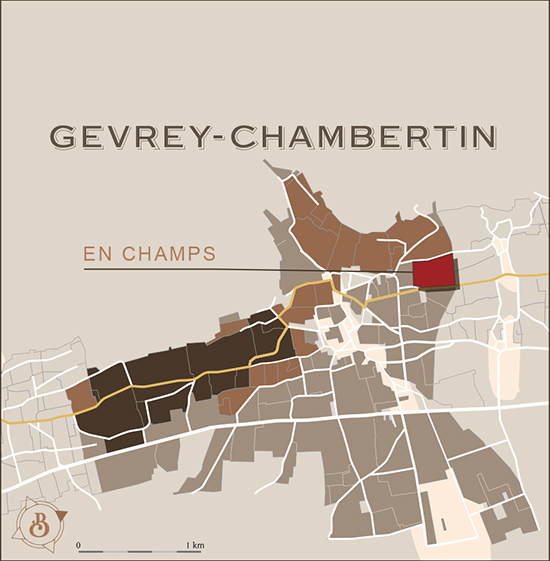Gevrey-Chambertin
En Champs Bio 2017
The name has prestigious overtones, and the place itself is about as noble as they come. To say the least, Gevrey-Chambertin is where the the real Burgundy Grands Crus begin…
Origin
Gevrey-Chambertin is a large town located at the northern end of the Côte de Nuits. It boasts one of the largest surface areas under vine with no fewer than 330 hectares under production. The vines are planted at altitudes of between 240 and 280 metres. The soil is limestone-based with a high proportion of clay marlstones from the scree of the Combe de Lavaux, giving power and roundness to the wines.
"En Champs" is located north of the appellation, on the hillside of Brochon which produces some of the most beautiful Gevrey-Chambertin villages.
The grapes selected from this cuvée are certified Ecocert.
Viticulture
Grape variety: pinot noir
Soils: fairly lean and made up of sandy marls.
Orientation: East
Surface area under vine: 0.1621 ha
Pruning: Guyot system
Yield: 45 hL/ha
Average age of the vines: 90 years old.
Vinification
Harvest date: 10 September 2017.
The grapes were sorted a first time in the vineyard and a second time on the sorting table when they arrived at the winery.
At the winery: the grapes were 50% destemmed but not crushed (they were left whole) and were gravity-fed into tanks. Maceration with 50% whole bunches of 19 days including 4 days cold (12 ° C): Fermentation used indigenous yeasts only (no additives such as enzymes or tannins were used). Vinification without sulfur. 7 punchings of the cap.
Ageing
Maturation: aged on the lees for 16 months with no racking using a proportion of 50% new French oak barrels.
Barrels: French oak barrels that had been toasted at low temperatures for a long time for very delicate oaking.
Bottling
Bottling in March 2019, the wine was very gently filtered before being bottled using gravity.
Number of bottles: 737 & 120 magnums.
Vintage
2017 , finesse
The growing cycle was thrown off-kilter by a very cold winter, late spring frost, then optimal conditions for rapid flowering, sporadic hail, and summer drought. Harvesting began in early September in the sun, and after several lean years, the vines finally produced abundant grapes, although with significant differences in maturity between whites and reds and from one region to another, which called for strict sorting.
Ageing potential: from 6 to 15 years.
Tasting notes
With a deep red color and garnet highlights, the intense nose exudes notes of red fruit, as well as spices with beautiful aging notes. On the palate, this wine turns out to be robust with a dense material and a pleasant tension in the finish.



